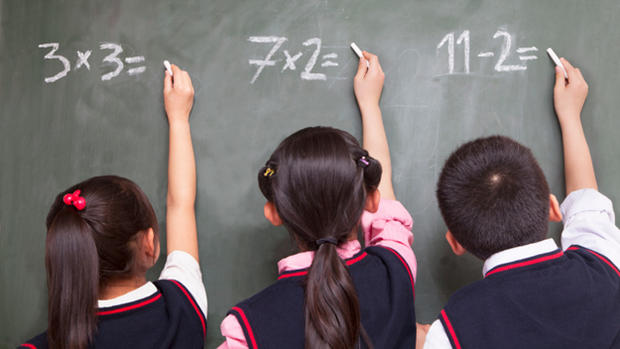California Educator Changes Common Core Math Attitudes
This article is presented in partnership with CA Lottery.
Math is a term that often strikes intimidation and anxiety into the hearts of many students. Even as adults, people who believe they are not good in math, tend to shy away from what's viewed as unnecessary calculations, extraneous word problems and intense formulas.
As hard as it may be to accept, math in itself is not as scary as it seems.
That's what Westborough Middle School teacher Antoinette Villarin shares with her class daily. She believes everyone can learn math, they just need the right approach.
Villarin teaches Geometry, an advance course for students, and she also teaches a class for students who struggle with math. Over her 13 years of teaching the subject, Villarin has observed one key difference that lies between students who do well in math and those who do not: the confidence to identify strategies for solving problems.
"You will see really strong problem solvers step back and visit the problem using different strategy. Whereas other students who don't have this same kind of problem solving strategy will sometimes give up or they will ask for help without having any real solution to how they might approach the problem," said the South San Francisco educator.
The answer to this "problem" come in two parts.
First, it's important to help students build up their confidence. Secondly, teachers must make sure they provide a safe, non-critical environment for struggling math students to work in.
"Kids that struggle need more support. They need more questioning to get them heading in the correct direction. When they do something correct say 'That was awesome job on how you solved that problem.' By giving them more encouragement they are more apt to share and try new things in class," said Villarin.
Villarin acknowledges that math is not the easiest subject for anyone. She sees students coming into her class that are really discouraged because they have not been successful in math for many years. Half the battle of developing successful math students is changing old negative thinking that causes them not to believe in themselves.
Personal Triumphs And A Willingness To Persist
Villarin is on a mission to teach her students how to be persistent. She wants them to not only face math fearlessly but even consider careers fields that use math. She lets her students know that math was not always her best subject either, but she was determined to succeed.
"I was not always the strongest in it all of the time, but I was persistent and I liked the challenge of trying to get the answer. I hope to share that with my own students," Villarin added.
Breaking through the idea of failure requires true dedication to supporting student's efforts while teaching.
Villarin tells young people, "As students, your clear role is to be persistence in how you approach math and that will determine if you will be successful. You may be surprised how far you go."
Another thing Villarin does is make math relevant for her students by connecting it to real life.
"When it's connected to real life I feel it's becomes meaningful to them verses when it's just an isolated skill that they need to know", said Villarin.
It's important for Villarin to make sure she gives her students every opportunity to learn and master math because no one really knows just what the future may hold.
Villarin said, "I do my best and I hope that I've encouraged them so that when they move into high school and college, and as young adults, they will be encouraged to do something in the math field. That would be pretty exciting."
With new testing beginning in California schools, students, teachers and parents are all concerned about the impact of Common Core Standards on test scores. Villarin and others are learning all the new details about the math portion of the test. While everyone is nervous about it, Villarin said she is also excited. She sees the new test process important because it requires students to demonstrate how they arrived at an answers as oppose to just picking the right answer, meaning students will need to understand what they are doing.
"The computer test will not just be multiple choice but, for example, may ask students a question like: There is an error in this problem, which is the error? Out of these four choices select all that apply," explained Villarin.
Change is always hard and so is approaching tasks that are perceived as difficult. But Geometry teacher Antoinette Villarin has confidence in all her math students, and she pushes them to have confidence in themselves.
Nicole Bailey-Covin is a public school education writer for Examiner.com.




